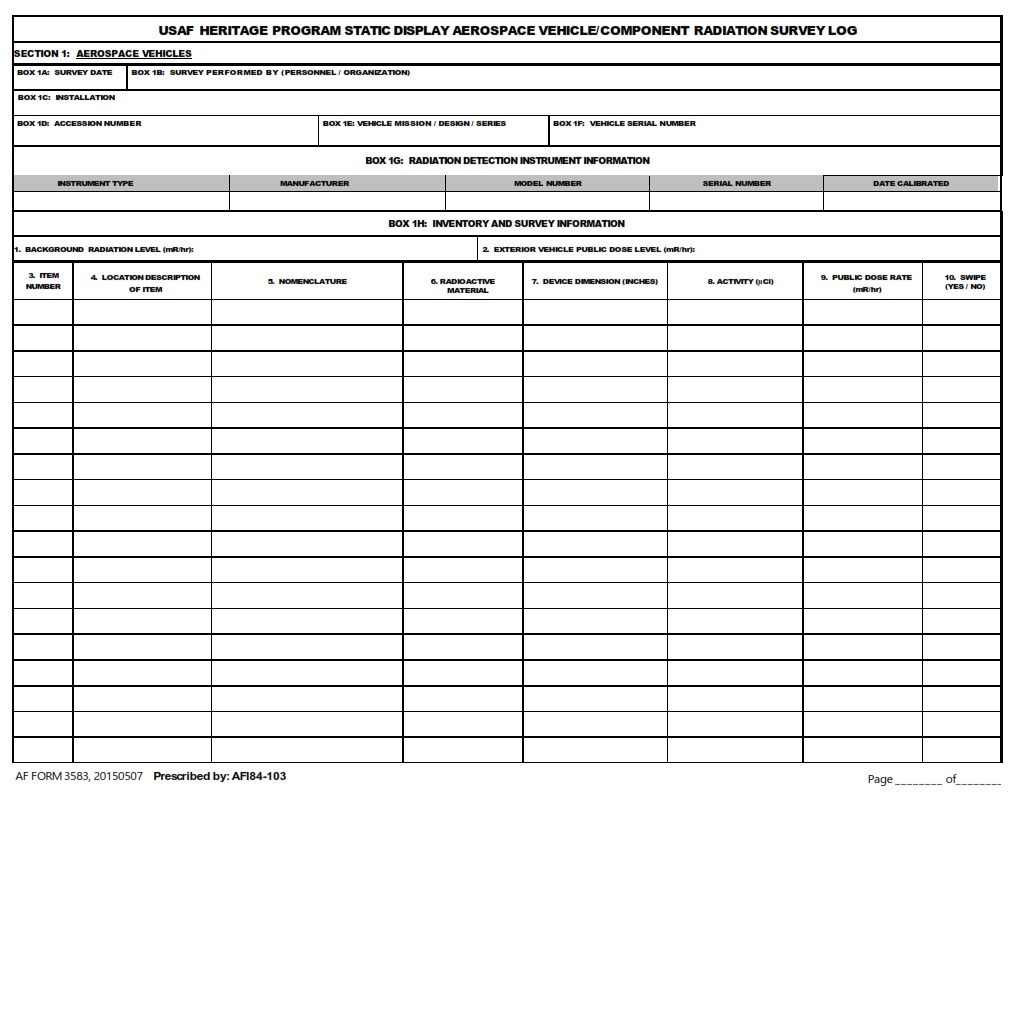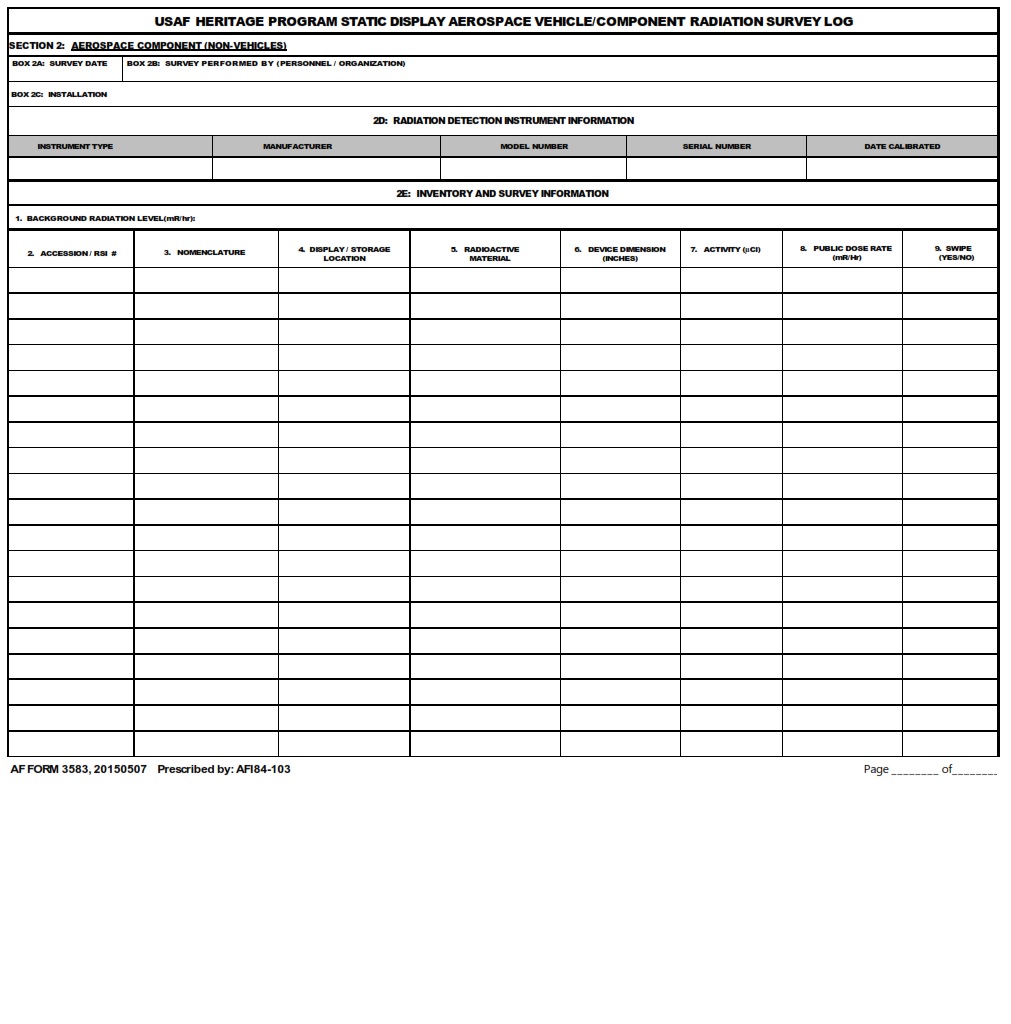AF-FORMS.COM – AF Form 3583 – Usaf Heritage Program Static Display Aerospace Vehicle/Component Radiation Survey Log – The AF Form 3583, also known as the USAF Heritage Program Static Display Aerospace Vehicle Component Radiation Survey Log, plays a crucial role in ensuring the safety and longevity of aerospace vehicles on static display. As part of the United States Air Force (USAF) Heritage Program, this log serves as a comprehensive record of radiation surveys conducted on various aerospace vehicle components. By meticulously documenting radiation levels and measurements, the log aids in assessing potential risks associated with these components and helps maintain compliance with radiation safety regulations. This article delves into the significance of AF Form 3583 within the USAF Heritage Program and explores how it contributes to preserving both historical artifacts and personnel safety.
Download AF Form 3583 – Usaf Heritage Program Static Display Aerospace Vehicle/Component Radiation Survey Log
| Form Number | AF Form 3583 |
| Form Title | Usaf Heritage Program Static Display Aerospace Vehicle/Component Radiation Survey Log |
| Edition Date | 5/7/2015 |
| File Size | 286 KB |
What is an AF Form 3583?
AF Form 3583 is a document used in the United States Air Force Heritage Program to track and log radiation surveys of aerospace vehicle components. This form is specifically designed to monitor the levels of radiation emitted from static display aerospace vehicles, ensuring the safety of both personnel and visitors. It serves as a vital tool for maintaining compliance with regulations and guidelines regarding radiation exposure.
The purpose of AF Form 3583 is to record detailed information about each component’s radiation measurement, including the date and time of the survey, as well as the location and type of component being surveyed. The form also captures data on the specific instrument used for measuring radiation levels, along with any other pertinent details related to conducting an accurate survey.
By utilizing AF Form 3583, air force personnel can maintain a comprehensive record of all radiation surveys conducted within their jurisdiction. This blog provides valuable data that can be analyzed to identify trends or potential issues related to radiation exposure. Ultimately, this form plays a crucial role in safeguarding both military personnel working with aerospace vehicles and members of the public who may come into contact with these displays.
Where Can I Find an AF Form 3583?
AF Form 3583, also known as the USAF Heritage Program Static Display Aerospace Vehicle Component Radiation Survey Log, is an important document used by the United States Air Force to track and record radiation levels in aerospace vehicle components. This form plays a crucial role in ensuring the safety of personnel who work with these components and helps maintain compliance with radiation safety regulations.
To obtain an AF Form 3583, you can start by visiting your nearest Air Force base or military installation. The base’s Environmental Management Office should be able to provide you with a copy of the form or direct you to the appropriate department where it can be obtained. Additionally, many Air Force forms, including AF Form 3583, are available for download on official government websites such as e-Publishing.
It’s important to note that access to AF Form 3583 may be restricted due to security reasons and only authorized personnel may have direct access to it. Therefore, if you are not affiliated with the military or do not have proper clearance, it may be challenging to find this specific form.
AF Form 3583 – Usaf Heritage Program Static Display Aerospace Vehicle/Component Radiation Survey Log
The AF Form 3583 is an essential document used in the USAF Heritage Program to maintain and track radiation levels of aerospace vehicle components displayed in a static manner. This blog serves as a comprehensive record that ensures compliance with safety regulations and helps protect personnel and visitors from potential radiation hazards. By conducting regular surveys, the log allows for accurate monitoring of radiation levels over time, enabling prompt action if any component exceeds acceptable limits.
Each entry in the AF Form 3583 includes vital information such as the date, location, specific component surveyed, and corresponding measurements. The log also incorporates details about the equipment used for measuring radiation levels, ensuring consistency and accuracy across different surveys. By maintaining a thorough log of all survey results, USAF can demonstrate its commitment to safety protocols during inspections or audits conducted by regulatory bodies.
Overall, the AF Form 3583 plays a crucial role in upholding safety standards within the USAF Heritage Program’s static display operations. It serves as an integral tool for documenting radiation levels accurately while providing valuable data for ongoing monitoring purposes. Through meticulous record-keeping, this form aids in safeguarding both personnel and visitors who come into contact with these aerospace vehicle components on public display at various locations around the world.
AF Form 3583 Example

